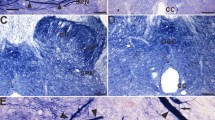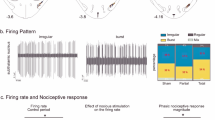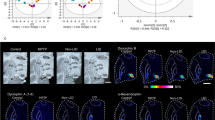Abstract
Substance P is an undecapeptide which may be involved in transmission of nociceptive information at synapses of primary sensory neurones1,2. It occurs in 10–20% of rat dorsal root ganglion neurones3,4. Small substance P-immunoreactive (SP-IR) axons from dorsal root ganglia enter the spinal cord and form a dense terminal network in the substantia gelatinosa of the rat dorsal horn3; analogous fibres from the trigeminal ganglion terminate in the substantia gelatinosa of the spinal trigeminal tract of the medulla oblongata4,5, while sensory axons travelling via the petrosal and nodose ganglia terminate in the tractus solitarius of the medulla5–8. Substance P is also present in human spinal cord and pallido-nigral system9–12. In addition to sympathetic and parasympathetic abnormalities, patients with familial dysautonomia (the Riley–Day syndrome) have severe diminution of temperature and pain sensitivity, reduced populations of primary sensory neurones and small Lissauer's tracts13. It was thus postulated that a diminution of primary substance P axons might be demonstrable using immunocytochemistry. We report here the presence of anatomically discrete depletion of substance P immunoreactivity in the substantia gelatinosa of spinal cord and medulla of patients with familial dysautonomia. The results are consistent with the hypothesis that substance P is involved in the transmission of impulses related to pain.
This is a preview of subscription content, access via your institution
Access options
Subscribe to this journal
Receive 51 print issues and online access
$199.00 per year
only $3.90 per issue
Buy this article
- Purchase on Springer Link
- Instant access to full article PDF
Prices may be subject to local taxes which are calculated during checkout
Similar content being viewed by others
References
Nicoll, R. A., Schenker, C. & Leeman, S. E. A. Rev. Neurosci. 3, 227 (1980).
Henry, J. L. Brain Res. 114, 439 (1976).
Hokfelt, T. et al. Neuroscience 1, 131 (1976).
Cuello, A. C., DelFiacco, M. & Paxinos, G. Brain Res. 152, 499 (1978).
Sumal, K. K., Pickel, F. M., Miller, R. J. & Reis, D. J. Soc. Neurosci. 6, 353 (1980).
Maley, B. E. & Elde, R. P. Soc. Neurosci. 6, 355 (1980).
Helke, C. J., O'Donohue, T. L. & Jacobowitz, D. M. Peptides 1, 1 (1980).
Gillis, R. A., Helke, C. J., Hamilton, B. L., Norman, W. P. & Jacobowitz, D. M. Brain Res. 181, 476 (1980).
Cuello, A. C., Polak, F. & Pearse, A. G. E. Lancet ii, 1054 (1976).
de Lanerolle, N. C. & LaMotte, C. Soc. Neurosci. 6, 353 (1980).
Defendini, R., Nilaver, G., Zimmerman, E. A. & Tennyson, V. M. Soc. Neurosci. 6, 103 (1980).
Kanazawa, I., Bird, E., O'Connell, R. & Powell, D. Brain Res. 120, 387 (1977).
Pearson, J. J. autonomic nerv. Syst. 1, 119 (1979).
Cuello, A. C., Galfre, G. & Milstein, C. in Receptors for Neurotransmitters and Peptide Hormones (eds Pepeu, G., Kuhar, M. J. & Enna, S. J.) 349 (Raven, New York, 1980).
Sternberger, L. Immunocytochemistry (Wiley, New York, 1979).
Cooper, P. E., Fernstrom, M. H., Leeman, S. E. & Martin, J. B. Soc. Neurosci. 6, 680 (1980).
Emson, P. C., Arregui, A., Clement-Jones, V., Sandberg, B. E. B. & Rossor, M. Brain Res. 199, 147 (1980).
Author information
Authors and Affiliations
Rights and permissions
About this article
Cite this article
Pearson, J., Brandeis, L. & Cuello, A. Depletion of substance P-containing axons in substantia gelatinosa of patients with diminished pain sensitivity. Nature 295, 61–63 (1982). https://doi.org/10.1038/295061a0
Received:
Accepted:
Issue Date:
DOI: https://doi.org/10.1038/295061a0
This article is cited by
-
Changes in substance P and NK1 receptor immunohistochemistry following human spinal cord injury
Spinal Cord (2014)
-
The human cuneate nucleus contains discrete subregions whose neurochemical features match those of the relay nuclei for nociceptive information
Brain Structure and Function (2014)
-
A world without pain or tears*
Clinical Autonomic Research (2006)
-
Substance P-like immunoreactivity and somatostatin-like immunoreactivity in the ventricular fluid of patients with chronic pain syndromes
European Archives of Psychiatry and Clinical Neuroscience (1991)
-
Calcineurin and synaptophysin in the human spinal cord of normal individuals and patients with familial dysautonomia
Acta Neuropathologica (1990)
Comments
By submitting a comment you agree to abide by our Terms and Community Guidelines. If you find something abusive or that does not comply with our terms or guidelines please flag it as inappropriate.



